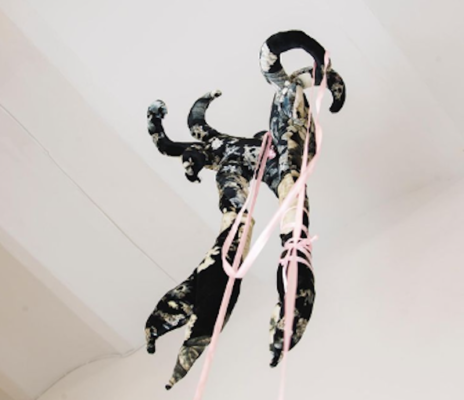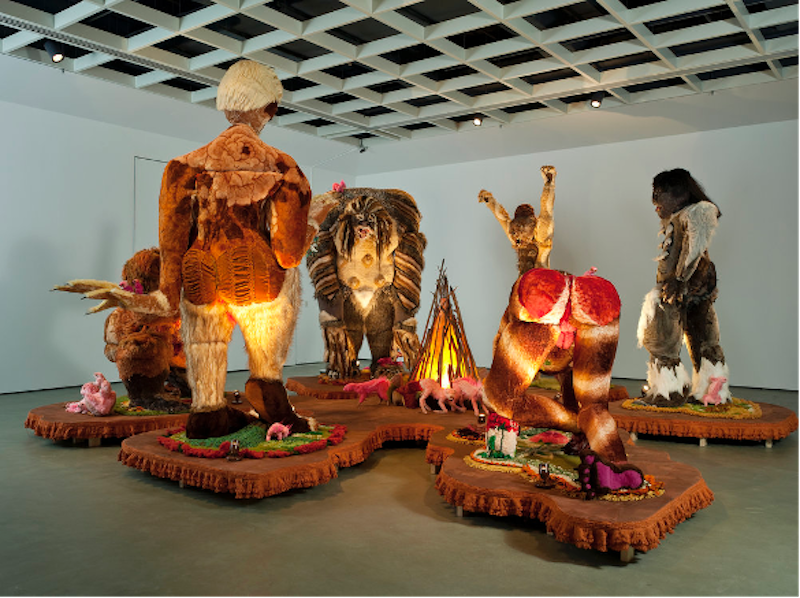Search
To search for an exact match, type the word or phrase you want in quotation marks.
A*DESK has been offering since 2002 contents about criticism and contemporary art. A*DESK has become consolidated thanks to all those who have believed in the project, all those who have followed us, debating, participating and collaborating. Many people have collaborated with A*DESK, and continue to do so. Their efforts, knowledge and belief in the project are what make it grow internationally. At A*DESK we have also generated work for over one hundred professionals in culture, from small collaborations with reviews and classes, to more prolonged and intense collaborations.
At A*DESK we believe in the need for free and universal access to culture and knowledge. We want to carry on being independent, remaining open to more ideas and opinions. If you believe in A*DESK, we need your backing to be able to continue. You can now participate in the project by supporting it. You can choose how much you want to contribute to the project.
You can decide how much you want to bring to the project.

Since 2018 I have been thinking about the concept of “nueva sinceridad”, this umbrella term that we appropriate by mistranslating the Anglo-Saxon New Sincerity and which consists of that threshold of mistrust that is generated between extreme and somewhat exaggerated sincerity and disaffected post-irony.
On this occasion I wanted to address the new sincerity from the idea of repetition, of things that return, cyclical temporalities, spirals, deja vu, anachronism or mythical thought and its relationship with queer temporalities and aesthetics. I want to think that there is something neo-sincere in what returns, because laps are never entirely genuine. When something comes back into fashion, it intermingles with the contemporary and thus gives rise to aesthetic forms of pastiche, of mixture. Strange anachronisms are generated that create suspicion about whether that aesthetic is ironic or sincere. As we have all learned from movies: “Sequels were never good.”
One of the things that led me to think about the new sincerity in relation to repetition and queer aesthetics is this little card by Fernanda Laguna that María Salgado gave us in a session of the Euraca seminar on the Argentine editorial Belleza y felicidad (Beauty and Happiness). Something small. Like a very small letter of invitation that came to us and that should never have reached us. A gift.

¡Vamos nenx! by Fernanda Laguna, image of the author
According to Cynthia Francica, a good part of the editions of Belleza y felicidad have to do with this gesture of giving a gift, through small objects such as earrings or toys that were included inside the plastic bags in which the fanzines were wrapped[1]FRANCICA, Cynthia (2015) “Lo ‘queer infantil’ en la literatura de Belleza y Felicidad. Temporalidad, crisis y política.” en Pretérito Indefinido: Afectos y emociones en las … Continue reading. This toy that is given as a gift turns the reader into a child and the book into an object to play with. Thus, a children’s journey is produced in which the reader becomes a child through the fantastic, cheesy children’s stories that define these editions. But where this childishness is also charged with eroticism and queer sex, where the infantile, therefore, is reappropriated to be the means of narrating queer experiences and stories.
This desire for vulnerability or queer childishness does not simply have to do with a childhood desire, but with a denied childhood where writing can become, as Camila Sosa says, an exercise of cradling and tenderness that allows us to also evoke the childhoods that we didn’t have: “I’m always on my childish round, circling within myself. I have another age when I write. I am a perverse and troubled transvestite little girl. I am the child who runs away from her parents and ends up in the arms of literature. Or that she finally cradles herself when she writes”[2]SOSA VILLADA, Camila (2021) El viaje inútil, Segovia: La Uña Rota, p. 29.. But I insist, the returns are always for the second time, they are never completely genuine, sincere, and therefore our parents no longer cradle us, but we cradle ourselves, as Camila Sosa says: finally.
This return of tenderness, this finallyof a denied vulnerability, makes me think of what Sianne Ngai identifies as a turn towards the pleasant within contemporary aesthetic currents. In Our Aesthetic Categories: Zany, Cute, InterestingNgai tells us that cuteness has to do with little things, beings and objects that generate a desire for protection in the face of their vulnerability and particularly with the domestic[3]NGAI, Sianne (2010) Our Aesthetic Categories: Zany, Cute, Interesting, Cambridge: Harvard University Press.. Aesthetics that we could call padded, furry, but also and in many cases alien and monstrous. Soft images and beings, that you want to touch, that touch us.
ASMR 360º (VR-IMMERSIVE) -💖ERES MI MUÑECA, BIENVENIDO A MI CASA DE MUÑECAS ASMR💖de Cruelaudia, 2019
Elizabeth Freeman talks about the erotic relationship that we develop with certain works of art, with images, which refer to tactile sensations and that, for her, is closely related to the production of queer art[4]FREEMAN, Elizabeth (2010) Time Binds, Durham: Duke University Press.. Soft sculptures that we cannot touch, oil paintings in museums that we cannot suck, avatars and images of digital fairies that we cannot caress, that we cannot embrace. All these images invite us to think of an aesthetic to come, some non-anthropomorphic codes to come and awaken an unknown eroticism where the stuffed animal becomes a means of storytelling of kinder, sweeter and softer futures.

Allyson Mitchell, Ladies Sasquatch, 2006-2010
With my friend, fellow ontologist and partner in crime Laura Tabarés we coined a term, which I now also give to you, readers, which is elvish ugliness. The elvish ugliness represents, precisely, this neo-sincere, suspicious gesture, that adults claim these aesthetics that they lived in their adolescence, in their childhood but that in this return, they do it in a fantastic way. A little warped, even. The elvish ugliness, the cottagecore, the fairycore, the furry, the neosincere. All these terms that I am throwing at you can help us to think of a queer aesthetic, one that embraces non-linear temporalities and that criticizes the chrononormativity that Elizabeth Freeman speaks of with these crazy turns. Those that make figures and stories that were left behind come back. In childhood, but also in myth or fantasy. Heather Love also talks in her book Feeling Backward about how queer aesthetics have to do with the gesture of looking back, of turning or what comes back. History would be full of references to these subjects who do not meet the modern mandate of progression and who turn around, stay behind, do not advance[5]LOVE, Heather (2007) Feeling Backward, Loss and the Politics of Queer History. The mermaids themselves, which have also been discussed in this monograph, are those that make us return, with their song, to a past time. Those that retain those who wanted to advance.
I ask the editor of the month of this Magazine, blanca arias, what relationship she finds with this claim of elven aesthetics, fairies, fantasy genealogies from a queer perspective that embraces children’s temporalities and aesthetics in relation to her artistic production and specifically in relation to his piece Bolloisla. She tells me that when she was making the piece she found that the complexity of creating a 3D world also happened because she often had to simplify things. And that in this simplification she chose well-known images from her adolescence, like some seedy png wings similar to the ones she would have sent on Messenger.

blanca arias, Bolloisla, still, 2020
But who also read the final chapter of Donna Haraway’s Staying With the Trouble, where she sets out a speculative story for sustainable futures in interplay with other species. In this text, Haraway generates an entire mythology, some new queer myths, strange, centered on the monarch butterflies and their relationship with the Children of Compost, which made her consider those same characters in posthuman terms, questioning why it means that those bodies have wings. In this desire to continue thinking about fairies, there is something connected with a belief and a yearning for the fantastic in childhood, but also to think of new mythologies in the future.
Going over the same thing so many times to make time go unrecognized, to keep going crazy. Doing exercises of repetition, memorization, forgetting and generation of legends and myths. Of new legends, too. Staying with the trouble, which comes back again and again, also implies generating mythologies to deal with the queer and strange futures that we need.
[Front images: Irene Izard, Alas negras (Cuervo), 2021. Imagen of the exhibition Rebel Soft, Casa Antillón]
| ↑1 | FRANCICA, Cynthia (2015) “Lo ‘queer infantil’ en la literatura de Belleza y Felicidad. Temporalidad, crisis y política.” en Pretérito Indefinido: Afectos y emociones en las aproximaciones al pasado, Buenos Aires: Blatt & Ríos. |
|---|---|
| ↑2 | SOSA VILLADA, Camila (2021) El viaje inútil, Segovia: La Uña Rota, p. 29. |
| ↑3 | NGAI, Sianne (2010) Our Aesthetic Categories: Zany, Cute, Interesting, Cambridge: Harvard University Press. |
| ↑4 | FREEMAN, Elizabeth (2010) Time Binds, Durham: Duke University Press. |
| ↑5 | LOVE, Heather (2007) Feeling Backward, Loss and the Politics of Queer History |

Elena Castro Córdoba (Madrid, 1993) has a degree in Philosophy (UCM) and a Master in Gender, Media and Culture (Goldsmiths University). She is a predoctoral fellow at the Complutense University where she is working on a thesis on queer and affective temporalities. She researches and writes on contemporary feminism, archiving, temporal politics and their interrelation with contemporary aesthetics. She is also a member of the cultural production collective Ontologías Feministas, which specializes in virtuality and activities with a feminist perspective. She shares with them the dream of being students, teachers and directors of their own school.
"A desk is a dangerous place from which to watch the world" (John Le Carré)